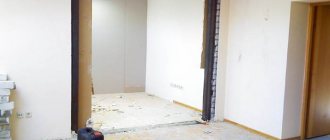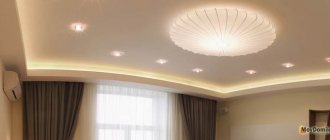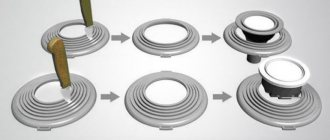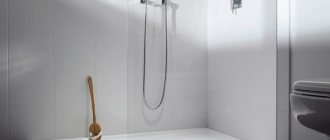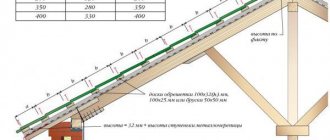Usually people buy furniture, paintings and other necessary and not so necessary interior items and furnishings, taking into account the configuration of their apartment. In most cases, this works, and the table falls into place without problems. The sofa fits perfectly between the corner and the door in a small room. The comfortable double bed is protected not only from prying eyes, but also from drafts. However, sometimes the realization suddenly comes that you will have to do some redevelopment and move the doorway. Otherwise, living in an apartment will be very inconvenient.
Of course, it is much easier to reconsider your views on the interior or purchase other furniture. But in some cases it will be more expensive, and it is prohibited to bring something new into your own apartment only if it is provided for by the housing code and is not a threat to the entire building.
Preparatory work
Before creating a new doorway in the load-bearing wall of a panel house, you need to carefully prepare for your plan. First of all, you need to take into account some features:
- Talk to the residents of the lower and upper apartments. Ask them about the presence of additional doorways in the load-bearing walls - to maintain the integrity of the house, you need to try to make sure that they match.
- We must not forget that with the number of floors the load on the supporting structures increases. When creating a doorway in multi-story buildings, you need to make additional reinforcement of the wall.
- Prepare a design for the future passage in advance. You can simply move the existing opening to the side, make a rectangular or arched passage.
However, before carrying out such full-scale work, it is necessary to obtain permission from the administration under whose control the panel or brick house is located.
Coordination of redevelopment
The question of whether it is possible to make a doorway in a load-bearing wall should be decided by the administration of the housing complex in which the apartment is located. There is a law that obliges any person who owns an apartment to coordinate major redevelopment with the administration. This applies to the addition of new heating units, plumbing work and capital construction.
Carrying out work without approval from higher authorities can lead not only to administrative liability, but also to the destruction of load-bearing structures.
The owner of the apartment must draw up a plan in which the process of creating a doorway will be described step by step, indicating its shape and dimensions. In addition to this, you need to indicate all the little things so as not to encounter serious problems in the future. And also we must not forget about the description of reinforcement with decorative columns or lintels, if they are planned.
People living on the upper floors have a better chance of obtaining permission to carry out work to create new openings in load-bearing structures.
Breaking does not build!
To begin with, it is necessary to carry out a number of preparatory processes. A lintel is pre-fabricated, which will take on the entire main load from the wall mass located above. This element is very important: the safety of the entire structure and yours, accordingly, will directly depend on its strength. In this case, the following must be considered:
- wall thickness,
- ratio of wall and opening size,
- technical condition of the wall,
- the material from which the walls are made,
- distance to adjacent walls and ceiling,
- location of floor slabs,
- number of floors above your apartment.
In the case where the opening is made in a large wall, the floor slabs should first be supported. For example, supports can be made from pipes or logs.
First, mark and make a temporary support
As for the material for the lintel, steel would be the ideal option. It is the most reliable and durable material for this purpose. As a rule, you can purchase a channel that is bolted on both sides or an I-beam. If you have chosen to install a channel, then M20 bolts are suitable for connecting it. The distance between them should be half a meter. The length of the jumper must be sufficient so that it does not bend under heavy loads.
Examples of openings in a load-bearing wall
Before a person finds out whether it is possible to cut a door in a load-bearing wall, it is necessary to create a design for the future opening. This applies to shape, location and size. In this case, there are 3 design options:
- Standard pass. A rectangular opening for installing a door with a frame. When creating a new opening, it is necessary to take into account the fact that the existing passage affects the distribution of the load. It can be left or bricked.
- Arch. A non-standard doorway shape, which is common in apartments with a classic interior style. When choosing this shape, it is necessary to take into account the features of the bends. If the house is brick, only a professional can do the work. This is due to the fact that you need to take into account the location of the seams in the masonry.
- Moving an existing passage a short distance to the left or right. It is considered the simplest and safest type of work. The existing opening is cut in the chosen direction, and its old part is covered with a brick partition.
After choosing a shape, you need to set the dimensions. The smaller the width of the passage, the greater the chance of obtaining permission to create it. This also applies to its height.
Drywall
Drywall is an excellent construction sheet material. Available and inexpensive. When creating a metal frame and filling the internal volume with insulation, it creates good sound insulation.
Advantages:
- easy;
- easy to process (possibility of building arches and other shapes);
- easy to install;
- no plaster required;
- non-flammable;
- environmentally friendly;
- maintains the microclimate of the room;
- It is possible to lay communications inside the frame.
Flaws:
- low impact strength;
- low sound insulation;
- When installed in rooms with high humidity, it requires additional waterproofing.
Necessary equipment and tools
If permission has been received from the administration, you need to prepare tools to create a passage. In this case, you can use power tools and specialized equipment. The second option includes:
- Diamond drilling. Special equipment is used, which is equipped with diamond drills. Their shape can be cone-shaped or square.
- Rope cutting. Special equipment, the essence of which is to move cutting ropes coated with diamond coating.
- Cutting a supporting structure with a diamond-coated saw on a working blade. Additionally, a spray gun is installed in the cutters. The water cools the disc and attracts dust.
Advice! There is no point in purchasing expensive installations to create an opening. You can rent them from construction organizations or hire a work team that will have similar equipment.
You can also make an opening using power tools. To carry out the work yourself you will need:
- A hammer drill, a large grinder or a jackhammer when working in a monolithic building.
- Chainsaw when working in an aerated concrete or wooden house. It is good for sawing timber or cellular blocks.
- Measuring tools.
- Sledgehammer, hammer.
- A small grinder for cutting tie reinforcement.
Before using a power tool, it is advisable to use a hidden wiring sensor to avoid getting caught in wires, pipes or fittings.
Step-by-step instructions for making a jumper
In order for everything to really work out correctly, the jumper must be made with maximum compliance with the assigned tasks. The developed step-by-step instructions can help with this. You just need to be careful and not skip technological steps:
- First you need to prepare the channels of the required size. For example, if we are talking about an opening of 2.5 m, it is better to take a three-meter steel channel No. 18.
- Then you will need to make holes in the channels for the tightening bolts (the recommended fastener diameter is 20 mm, and the length should be such that it allows them to protrude 50 mm from each side of the wall.
- Next, on the load-bearing wall that goes under the opening, you will need to mark the opening itself, as well as indicate the placement of the steel lintel.
- Then you need to drill through holes to indicate the location of the opening and lintel on the other side of the wall too.
- Then you will need to remove the plaster from the designated areas.
- Using a jackhammer or manually, you need to prepare niches (they are also called grooves) on both sides of the wall - for the subsequent installation of channels. The depth of the gouging should be about 10 cm, and the height - about 18.
- Next you need to prepare (drill) holes for the coupling bolts according to the markings.
- The seats for the channels must be cleaned most thoroughly. And then moisturize.
- Next, cement mortar is applied (cement grade M100, at a minimum, and preferably more).
- And using the pressing method, the channels are “set” - each in its place.
- Next, you will need to insert the mounting bolts through the corresponding holes and tighten them.
- Then each channel must be filled with brick or cellular concrete.
Stages of moving a doorway in a load-bearing wall
There is a certain procedure, subject to which a doorway can be made by a person who does not have specific skills. It is important to prepare tools and materials in advance so as not to be distracted during the process.
Strengthening the future opening
Strengthening the future structure is the most important stage. It will protect a person from a sudden collapse of a wall or ceiling near the place of work. For this purpose, temporary supports are created. A support is made from a metal support and two plates that rest against the floor and ceiling.
Cutting load-bearing wall
To maintain the integrity of the walls, it is advisable to abandon the jackhammer and hammer drill. These power tools create powerful shock vibrations, which can cause the opening to be larger than necessary and cracks to appear in the walls.
It is better to use specialized equipment, a gas cutter or a large grinder. Before cutting begins, the contour of the future opening is outlined using a measuring tool. The markings need to be deepened with a grinder on both sides. Then, you can start cutting right through the wall.
Advice! Experienced finishers recommend dividing the opening into several zones, each of which must be cut separately. This way you can make your work easier.
Securing the opening
After creating the passage, it needs to be strengthened. Metal channels are used for this. If the house is brick, it is enough to install one channel at the top of the opening. If the house is panel, you need to fix 3 metal elements - on top and on the sides.
Glass, plastic polycarbonate, acrylic
These materials are perfect for the construction of partitions of any type. They can be used either separately or in combination with other building materials - wood, metal, stone. Universal materials with the ability to create unique design solutions. Interchangeable with each other. They are aesthetic and do not require complex installation. It is possible to create frame and frameless structures.
One of the disadvantages is poor sound insulation. Plastic is susceptible to aging and can change color over time, while polycarbonate, glass and acrylic become cloudy over time.
Tips and tricks
Before starting work, it is important to carefully listen to the recommendations of experienced finishers:
- You can start using a power tool only after checking the wall using a hidden wiring sensor.
- Work cannot begin without approval from the administration.
- If cracks appear on the walls or ceiling, stop work.
- Additional temporary reinforcement can be made from a jack, two wooden panels and a metal pipe. You need to secure the pipe to a jack, place one wooden shield under its base, and a second one at the end of the pipe.
- In a wooden or aerated concrete house, openings can be made either during construction or after its completion. In the second case, building materials will be used uneconomically.
Brick
Brick is often used for the construction of interior partitions. Solid, hollow, decorative, backfill, clinker are used.
Its advantages:
- environmental friendliness - made only from natural raw materials without harmful additives;
- good sound insulation;
- moisture resistance – absorbs moisture poorly and is resistant to mold;
- fire resistance;
- strength and durability (easily withstand the weight of any heavy household appliances).
Flaws:
- heavy weight;
- labor-intensive manufacturing;
- high cost of materials and work.
Finishing the appearance of the opening
After creating the opening, you need to make a beautiful finish. If a door frame is to be installed, it is necessary to prepare platbands and extensions.
If the owner has made an arched passage or does not want to install a door, the finishing must be done using plaster and putty. Step-by-step actions:
- Before finishing begins, the working surface is cleared of debris and dust.
- The areas where the plaster will be applied are coated with a primer.
- After the soil has dried, perforated corners are fixed to the corners of the opening, maintaining the level.
- The first layer of coarse plaster is applied.
- A reinforcing mesh is placed on the applied layer.
- A layer of fine-grained plaster is applied to the mesh.
- The prepared surface is cleaned before finishing work (decorative plaster, putty).
It is worth making every effort and carefully monitoring the application of each layer to ensure a decent result.
Wood, MDF, chipboard
Wood, MDF, chipboard are excellent materials that create comfort in the home. It is possible to build both stationary and transformers. Can be combined with other materials. Partitions made from these materials are:
- frame-panel;
- solid;
- carpentry.
Advantages:
- retain heat well;
- strong and durable;
- easy to install;
- easy to process;
- natural material is used.
Flaws:
- hygroscopic (require additional treatment with water-repellent impregnations);
- subject to fire;
- Chipboard is made from sawdust using phenolic resins
- Insects may appear.
How not to make openings in load-bearing walls
When carrying out redevelopment, a new doorway in a load-bearing wall may be needed if:
- association of apartments;
- extension of the bathroom to the corridor leading to the kitchen - in this case, a new entrance is needed through the living room;
- combining a kitchen with a living room, etc.
However, the installation of a new doorway not only makes the apartment more comfortable for living, and the non-residential premises more functional, but also implies responsibility for the implementation of such redevelopment.
Responsibility under the law
Law
Russian legislation has far-sightedly provided for the actions of some self-confident tenants who decided to ignore all of the above and move the doorway in the apartment on their own. Administrative punishment for such actions will follow sooner or later. This can be a fairly significant fine, calculated in a tidy sum, which is beyond the means of the majority of the population of our country. Or an order to return everything to its original state, and at your own expense, which will also cause a significant loss to the family budget. It is worth noting that if the redevelopment was carried out by previous residents, and for some reason this was not discovered earlier, then those who currently live in the apartment will have to eliminate all changes that do not comply with the law. So when buying an apartment, you need to pay attention to this and obtain the necessary documents in order to avoid troubles later.
Legality of constructing an opening in a load-bearing wall
It is important to remember here that you cannot make an opening in load-bearing walls without first approving such a redevelopment . Unauthorized touching of capital structures can lead to an accident, an accident, penalties and an order from government authorities to return the apartment to its original appearance, and at one’s own expense.
To approve an opening in a load-bearing wall, you will need two fundamental documents:
- Technical report (it must be ordered from the author of the house project).
- Redevelopment project with a section on strengthening the doorway.
If the author of the house project is not known, you must apply for a technical conclusion to the State Unitary Enterprise MoszhilNIIproekt. This state organization was authorized by the Moscow Government to develop technical conclusions for buildings built according to an individual project, the authors of which, for various reasons, have lost their legal force.
Most often these are apartment buildings built before the 50s, whose authors cannot be identified today. Or modern monolithic houses, built according to a one-time project, the developer of which has ceased to exist.
By the way, we provide assistance in obtaining a technical opinion from the author of the house project, since we have many years of successful experience in cooperation with all the leading research and design institutes in Moscow .
The redevelopment project is developed by any organization with an SRO certificate. This can be done for you by our partner - a well-proven design bureau that draws up project documentation in accordance with all current standards and rules, as a result of which the prepared redevelopment projects are successfully coordinated with the Moscow Housing Inspectorate and the administrations of cities near Moscow.
Without knowing the intricacies of the legislation, many owners agree to install an opening in load-bearing walls based only on a design project. However, the redevelopment project and the design project of the apartment are two completely different documents .
A design project allows you to understand what your apartment will look like after renovation work. This project is prepared by a designer who, relying on his taste, professional experience and knowledge, offers options for interior color design, finishing methods, “arranges” furniture, etc. All this, of course, helps a lot when planning and carrying out repairs.
You just need to take into account that the design project is an unofficial document that does not have any legal force when carrying out complex redevelopments. It is being prepared exclusively for you and cannot be approved if an opening was made in the load-bearing wall during repairs. Therefore, redevelopment carried out on the basis of a design project will be considered illegal, which is fraught with serious problems for the homeowner.
Read about redevelopment projects here.
Unlike a design project, a redevelopment project has full legal status and it is this that is submitted to the Moscow Housing Inspectorate for approval, after which permission is obtained for redevelopment, and, accordingly, for the construction of a new doorway.
And you shouldn’t listen to the opinion of those builders who will try to convince you to make an opening in a load-bearing wall without any approval, saying: “We’ve already done this a hundred times, renovating other apartments, and nothing happened .
Firstly, the habit of carrying out repair work without approved project documentation most likely indicates their illegal status, and, therefore, low qualifications and professionalism.
Secondly, by breaking through an opening without taking into account the technical characteristics of the building and premises, and without taking into account the condition of the supporting structures, such builders risk allowing partial or complete collapse of the structure, which means they put the health and life of you and your loved ones at risk.
Ultimately, if an illegal redevelopment is discovered, you will also have to pay a fine and return the layout to its original state at your own expense.
What to do if there is no floor plan?
Some points you should know:
- If the wall faces the street, then it is supporting;
- Walls near the landing;
- Walls that are shared with neighbors.
These rules are quite simple and understandable to everyone.
An important factor is also the floor on which the apartment is located. The higher the floor, the easier the work will be. Very often there are cases where it is prohibited to make such an opening in an apartment located on the ground floor. The type of house, layout and various other factors are taken into account. You should ask your neighbors above and below if they have had such work done. Indeed, in this case, it will be more difficult to do this in your apartment, since the openings are made one above the other, and not in a chaotic manner.
Important! Do not forget about the approval of such redevelopment. Otherwise, the owner of the apartment will be fined, and will also be asked to return everything to its original state.
People's lives depend on the quality of work performed. You should pay great attention to even small things that at first glance are unimportant. After all, if you do something wrong, the consequences can be irreversible.
Prohibitions on the construction of openings in load-bearing walls during physical work
To create an opening, it is very risky and inconvenient to use outdated impact equipment (jackhammer, scrap metal, sledgehammer, hammer drill), which has a destructive effect on the surface being treated - concrete and brickwork.
The use of such a tool leads to cracks appearing in the concrete and the brick begins to crumble. This violates the strength and stability of the building’s load-bearing structures and is fraught with tragic consequences.
The result of using percussion tools when constructing doorways:
Today, diamond cutting is used to cut out a door or window opening in a wall. Moreover, the design documentation provides clear instructions to limit or completely prohibit the use of traditional tools, and instead it is recommended to use diamond equipment when partially dismantling main walls.
In addition, it is forbidden to violate the technology for laying a cut out fragment of a wall on the floor, sawing it into blocks and transporting them, because if a piece of concrete weighing several tens of kilograms falls, the interfloor ceiling may be damaged.
“Knocked out” opening in a brick wall
No technology was used at all when constructing this opening. Usually, with the most primitive “technology”, the contours of the opening are “cut” with a grinder to the depth of its recess on both sides and then the opening is broken with an impact tool (a hammer drill, a drill with hammer mode, etc.). Here, there was neither one nor the other. The opening was simply “knocked out” with a sledgehammer and carefully “knocked” around the perimeter.
You also cannot deviate from the agreed redevelopment project, which, when installing a doorway in the wall, is provided with an additional section devoted to its reinforcement with metal structures and the general procedure for carrying out the work . They suggest:
- installation of safety racks;
- preliminary reinforcement of an opening that has not yet been cut with a transverse beam made of double angles or channels;
- installation of a reinforcement frame;
- caulking voids and gaps between metal reinforcement elements and the wall with cement mortar.
In order to comply with the order of construction and strengthening of the opening, before hiding the traces of the work performed behind the plaster, the organization that developed the design documentation and carries out the designer's supervision carries out control measures to establish the compliance of the completed repairs with the approved project .
Cellular concrete
Varieties of cellular concrete with a porous structure are foam blocks, expanded clay concrete and gas blocks, silicate and gypsum tongue-and-groove blocks. Widely used in the construction of interior partitions.
Advantages:
- light weight;
- environmental friendliness;
- fire resistance;
- easy to cut and process;
- resistant to rotting and fungal attack;
- easy to install;
- good thermal insulation;
- good sound insulation;
- durable.
Flaws:
- hygroscopic;
- require final finishing;
- not everyone can withstand the weight of heavy household appliances hung on the partition.
Redesign of doorways
Let's start the article with a fact: moving a doorway is a redevelopment, and apartment redevelopments have one distinctive feature - they all require approval in the prescribed manner. Some of them can be agreed upon according to a sketch or in a notification procedure, while some require a more thorough approach and more design documentation. The topic of our article: redevelopment of doorways and coordination of this construction event.
Despite the fact that moving a doorway does not require approval based on the redevelopment project, apartment owners quite often decide not to coordinate their actions at all. The situation when homeowners decide to unauthorizedly carry out redevelopment in the apartment today, unfortunately. Often, illegal redevelopment is carried out in violation of sanitary standards and threatens the safety of residents of the entire house. Seemingly insignificant changes in the layout of an apartment, such as redevelopment of doorways, carried out without approval, without developing a technical report and design documentation, can deteriorate the performance of the entire building, its supporting structures, and ceilings.
For example, remodeling a doorway such as moving or widening it, especially in load-bearing walls, can lead to an increase in load beyond what is permissible on the load-bearing structures of the house, especially if your neighbors above and below have done similar work in the same load-bearing wall. The conclusion is obvious: in order to avoid conflict situations when remodeling doorways, you must first legally register the redevelopment, that is, obtain official permission from the Housing Inspectorate and only then begin the work.
Apartment redevelopment project with relocation of the opening in a non-load-bearing wall, photo:
Coordination of redevelopment of a doorway in a non-load-bearing wall
In many apartments, the interior walls are non-load-bearing and approval of the redevelopment of doorways occurs “according to the sketch”. All planned changes are noted directly on the BTI floor plan. In order to coordinate this event, you will not need to obtain prior permission to begin repair work. You just need to make sure that the wall is not load-bearing. Having moved or expanded the doorway in the partition, you reflect your actions in a copy of the floor plan of the apartment (redevelopment sketch) and submit an application for acceptance of the apartment after the redevelopment. All that remains is to wait for the Moscow Housing Inspectorate employee, who will formalize the redevelopment as agreed upon.
Apartment redevelopment project with relocation of the opening in the load-bearing wall, photo:
Coordination of redevelopment of a doorway in a load-bearing wall
Redevelopment of a doorway in a load-bearing wall, including even a slight increase in the doorway, occurs according to the project and only on the basis of a technical conclusion. Most often, in such cases, additional reinforcement of the load-bearing wall with the help of metal structures is required. The regulations for the approval of redevelopment when affecting the load-bearing structures of the building provide for the development of a project based on a technical conclusion from the author of the house project.
The author of most of the panel houses in Moscow is OJSC MNIITEP, and if it is not possible to find the author, then you should contact the State Unitary Enterprise MoszhilNIIproekt. As a rule, the author of the project does not approve more than one opening in the load-bearing walls per apartment, however, there are situations in which the technical conclusion does not even require strengthening the opening with metal structures.
After the technical conclusion has been received, you should contact a design organization with SRO approval to develop a redevelopment project, and it is better to give preference to those companies that have been on the market for a long time. Once the project is ready, you need to supplement it with an application, a technical passport of the apartment and a copy of the title documents and submit it to the MFC. After 45 days, you will receive a decision on the redevelopment - a refusal or permission to begin repair work. As a rule, projects are not denied approval on the basis of a technical report from the author of the house. Having completed the work, you also notify the Moscow Housing Inspectorate about this and ensure the presence of representatives of the design and construction organization to accept the repairs after the redevelopment. After receiving the act of completed redevelopment, you will receive another inspection visit - this time from a BTI engineer. At this point, the redevelopment can be considered agreed upon.
Project for constructing an opening in a load-bearing wall between the kitchen and living room, photo:
The most common options for redesigning a doorway
If we talk about the redevelopment of partitions, then, as a rule, the transfer of a doorway involves dismantling the entire partition and installing a new one. The only limitation is the minimum opening width requirements (600 mm for a bathroom and 700 mm for living rooms). It is worth considering that the requirement is interpreted taking into account the installation of the door leaf, that is, the opening itself should be planned somewhat wider.
In load-bearing walls, there are much more requirements - for example, a doorway in a load-bearing wall should not be located closer than the minimum distance from the outer wall of the building. The exact values of this distance differ depending on the type of building and the series of the house.
Changing the direction of opening a door directly in your apartment is not a redevelopment in most cases, but if you, for example, plan to change the direction of opening a door from your apartment to a common corridor, then such redevelopment of the doorway can be difficult to coordinate. It should be taken into account that there are fire safety standards according to which the doors of emergency exits and doors on evacuation routes must open in the direction of exit from the building. The same fire safety rules will not allow you to approve the redevelopment of the doorway if, as a result, the door opens “to the neighbor” on the staircase. In this case, changing the direction of opening the door will interfere with the evacuation from the neighbor’s apartment.
One of the most common redevelopments involving the expansion of a doorway is its installation in a load-bearing wall between the living room and the kitchen. The area of the corridor that led from the entrance of the apartment to the kitchen is occupied by the area of the combined bathroom, and the passage to the kitchen is arranged from the living room. Otherwise, such redevelopments are difficult to systematize; if you wish, you can find confirmation of this in this section.
If you need the development of project documentation or its approval, then our company is always ready to help resolve this issue at an affordable price. Call or email us for a consultation.
Materials for a new partition
All partitions can be divided into:
- interior;
- decorative;
- zoning;
- soundproofing.
Based on their design, partitions are conventionally divided into:
- Stationary – completely separates the desired area from the total area. Usually made with good heat and sound insulation. It can be solid or with an opening.
- Movable – operate on the principle of a wardrobe. It is possible to combine or separate two zones. For example, a sliding wall between a room and a loggia.
- Suspended - lightweight structures for mounting to the ceiling.
- Transformers – accordion fencing made of wood, PVC or glass.
Depending on the purpose that the partition should serve, various materials are used for its manufacture:
- Brick;
- Drywall;
- Various types of gas-expanded clay concrete and foam blocks;
- Polycarbonate;
- Wood, MDF and chipboard;
- Metal-plastic blocks;
- Glass and glass blocks;
- Iron and aluminum.
Algorithm of actions
And now everything is ready. Sockets and switches, if they were, were removed, the wires were de-energized. The floor near the work site is covered. The doors to other rooms and the kitchen are tightly closed. We can begin.
- Using a tape measure, level and pencil, mark the new doorway on both sides of the wall.
- In some cases, a piece of wall that is planned to be removed must be supported on both sides to prevent it from collapsing.
- Using a grinder, carefully and slowly, we cut out the future doorway along the marked contour, starting from the top. Sawing is also done on both sides of the wall.
- We install the upper lintel, which will take on the weight of the wall remaining above the future door. The ends of the lintel should extend 8-10 cm into the wall on both sides of the doorway.
- We clean the new doorway that has formed and align the jambs.
- We insert the door frame. We level it using a plumb line, level and wedges and secure it with foam or cement mortar.
- We are hanging a new door.
- We close the old opening using one of the selected methods. Foam blocks, drywall or removed bricks.
- Let's clean up after ourselves. We take out the construction waste left after the work, wash the floor, and so on.
During the work, various nuances may arise, which will have to be eliminated as they arise. But if you adhere to the above algorithm, there should not be too many difficulties.
Consequences of unauthorized reorganization
Some citizens improve at their own discretion and live this way for years, but sometimes it happens that the deception is revealed. For example, when selling a home. It happens that a shower stall is installed, and no one will know about it. But if the neighbors are suddenly flooded, then information about the reconstruction may well become known to government agencies.
Important! The violator will have to pay a fine of up to 2.5 thousand rubles. and try to legitimize their actions after the fact. If the attempts are unsuccessful, the housing will have to be returned to its original form.
Bringing beauty
Cleaning up after yourself after finishing the work is not enough. An old doorway, even one that has been carefully and smoothly sealed, must be plastered, painted, or appropriate wallpaper applied to it. In most cases, the matter is not limited to this place alone, so it is best to plan the relocation of the doorway during the renovation of the entire room or even apartment. And here you can turn on your imagination to the fullest.
Relocating a door in an apartment is not the most common renovation procedure, since it is considered a redevelopment. Incorrect placement of the interior door interferes with the efficient use of space in the apartment. Therefore, there is only one way out - to move the doorway by installing a new frame with the door.
What changes will have to be abandoned?
What redevelopment is permitted is determined by law. Do's and don'ts must be followed by apartment owners. After all, a repair team can carry out almost any project for money. But whether such actions will be legal is another question.
3 prohibited techniques for changing the layout:
- placing a bathroom above the living rooms;
- connecting floor heating to general heating systems;
- connection between the room and the kitchen with a gas stove.
If the common property is annexed, then such actions are contrary to the law. Apartment owners have the same rights to the property of an apartment building.
Actions that threaten the integrity of the building and the normal operation of engineering structures are prohibited.

